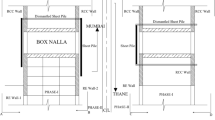Abstract
Forensic civil engineering can be considered as “The investigation of materials, products, structures or components that fail or do not operate or function as intended, causing personal injury or damage to property." This paper presents a case history of analysis and review of a touch pile system failure during deep excavation for a commercial building (3 basements, ground floor and 8 floors) near Metro Station Kaloor, Kerala. An excavation to a depth of 10 m from ground level was required to reach up to foundation level of the structure and to retain soil to facilitate the excavation; a retaining wall formed using touch pile system, where in multiple piles almost touching each other to support a change in elevation along with strutting was adopted. As the excavation was in progress, the shoring system collapsed at 9.30 pm on April 19, 2018. A technical expert committee was formed by District Disaster Management Authority, which comprised of authors to evaluate the reasons of failure. The immediate restoration steps adopted, various tests conducted to analyze the reasons for collapse, temporary measures adopted and precautions to be taken for future construction are presented. From the study, it was found that the strutting system was inadequate to take up the lateral thrust from the touch piles and soil at the dredge line has turned out to be very soft and has caused considerable loss of strength of the interface soil. Subsequent increase in unsupported length of pile is also a reason for the failure of retaining system.




















Similar content being viewed by others
References
Joseph A, Muralikrishna A (2015) Construction practices of deep basements. In: Proceedings of the 50th Indian Geotechnical Conference, Pune
Gandhi SR (2011) Behavior of single pile in sloping ground under static lateral load. In: Proceedings of the Indian Geotechnical Conference, Kochi
Moh ZC, Chin CT, (1991) Deep excavation in soft ground. In: Proceedings of ASIA Construction: New Frontiers, Singapore
Pearlman SL et al (2004) Drilled shafts, micro piling, deep mixing, remedial methods and speciality foundations, ASCE Geo-Support, Florida
Puller M (2003) Deep excavation a practical Manual, 2nd edn. Thomas Telford Ltd., 1 Heron Quay, London
Chang-Yu Ou (2006) Deep excavation: theory and practice. Taylor and Francis Group, London
Madhav MR, Abhishek SV (2016) Perspectives in forensic geotechnical engineering. In: Proceedings of 5th international conference on forensic geotechnical engineering, Dec. 8 to 10, 2016, IISc Bangalore
Saxena DS (2008) Case studies in forensic geotechnical and foundation engineering. In: International conference on case histories in geotechnical engineering, ASC Geosciences, Inc., Lakeland, Florida
ASTM D5882-16 (2016) Standard test method for low strain impact integrity testing of deep foundations. ASTM International, West Conshohocken, PA
Wang L, Hwang JH, Luo Z, Juang CH, Xiao J (2013) Probabilistic back analysis of slope failure—a case study in Taiwan. Comput Geotech 51:12–23
Sivakumar Babu GL, Vikas Pratap Singh (2016) Back analysis in geotechnical engineering, forensic geotechnical engineering. In: Developments in geotechnical engineering, pp 113–118
IS: 456 (2000) Indian standard code of practice for plain and reinforced concrete, Reaffirmed 2005
Nayak NV (1979) Foundation design manual. Dhanpat rai, New Delhi
Acknowledgements
Authors are thankful to District Disaster Management Authority and District Collector Shri K Mohammed Y Safirulla, IAS for entrusting the forensic study to the authors and also for proper implementation of the recommendations made.
Author information
Authors and Affiliations
Corresponding author
Additional information
Publisher's Note
Springer Nature remains neutral with regard to jurisdictional claims in published maps and institutional affiliations.
Rights and permissions
About this article
Cite this article
Joseph, A., Chandrakaran, S. & Jose, B.T. Forensic Study of an Earth Retaining System Failure. Indian Geotech J 51, 598–611 (2021). https://doi.org/10.1007/s40098-021-00532-9
Received:
Accepted:
Published:
Issue Date:
DOI: https://doi.org/10.1007/s40098-021-00532-9




